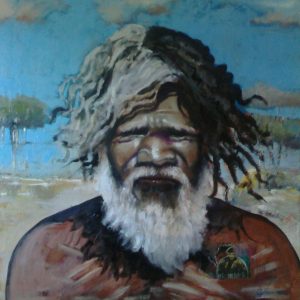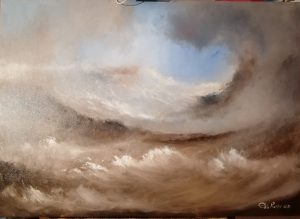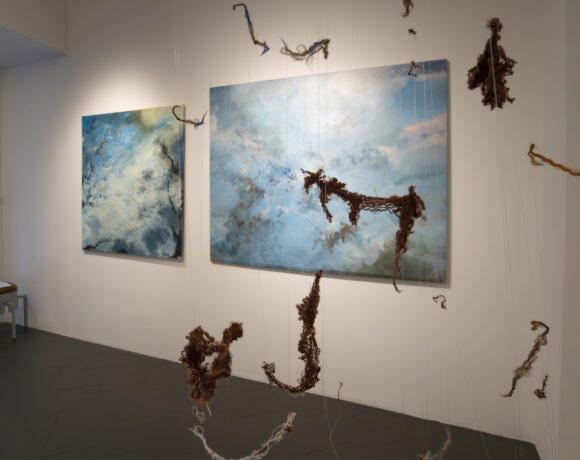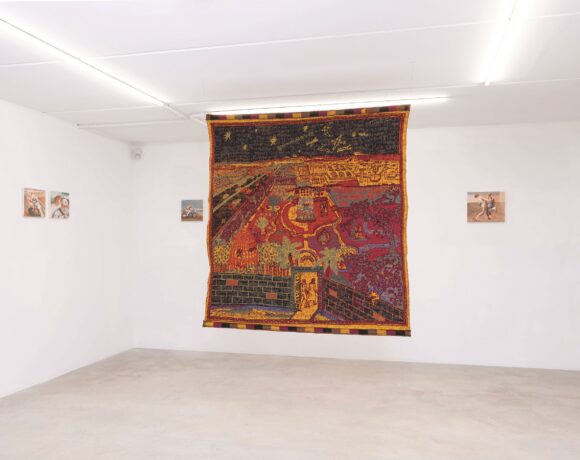The Western world has not known, in this century, any revolutionary process completed, and the image has been one of the active tools of criticism and of social and artistic revolt. There is a large amount of material available that could be collected and which concerns not only the figurative arts, but also theater, cinema, urban planning, music. The Samnite artist Elio Russo is the spokesperson for the figure of the aboriginal and his non-civilized world, placing himself in a committed artistic dimension, that of environmentalist art, possibly rendered on canvas. Elio Russo feels quite distant from the realm of installations, performances, serialities, he prefers figurative art that also springs from first-person experiences, such as the one that brought him to Australia and to meet the inhabitants of the Amazon forests, guardians of the Nature. Elio Russo’s art tells us that in the name of immediate political and mass-media recognition we cannot ignore the complexity of many experiences so that we can increasingly reduce the distance between producer and user, between politics and forms of creativity, that they were image, but also word, sound, gesture, experience and thought at the same time; without forgetting the tradition, the past. Russo’s works seem to echo Diderot’s conception of nature according to which it is culture, history, ethical-political choice, providing a seductive image of the wild in relation to a timeless dimension where existence is savored in its fullness. The artist from Benevento also loves using watercolor and graphite, experimenting from a chromatic point of view, and measuring himself with marked realism. However, it is curious how the art of Elio Russo provides the opportunity to debate once again around the eighteenth-century myth of the good savage behind which lies a contradiction that is not so much of the Enlightenment, but of a literary historiography that insists on to ignore the fact that Pre-Romanticism, with its myths, including that of the “good savage”, is only the other side of the coin of the Enlightenment; or that it is not a matter of two almost synchronic movements, but of a single movement with two faces, which elaborates two opposite but mirror-like conceptions of reality. Exalting instincts and nature, at the same time ridiculing intellectualism; it only confirms the adherence to the eighteenth-century rationalist concept. On the other hand, even anti-intellectualism is highly intellectual.
Annalina Grasso: Your art seems in some ways to wink at the myth of the good savage. Is it just this or is there a deeper reflection behind it?
Elio Russo: It’s a little bit of one and a little bit of the other. The aboriginal enjoys, ideally, on my part more esteem than I can have for some “civilized”. The figure of the aboriginal wants to speak to the world, he would like to advise and admonish from the depths of his primordial wisdom which is then the foundation of reason linked to respect for the Earth, for the universe, for life that continues if Nature is preserved and if it is draws sufficient benefit without raping her.
Art and literature in your opinion must annoy, reveal the true nature of things, or they have a purely “civil” role?
Art, literature and music seem to be very free means of expression and therefore, I think we can also expect them to have different roles, different languages, but as for writing, good grammar is required as well. for art an aesthetic and technical side is assumed that they are recognized and appreciated.
What kind of beauty do you find in contemporary art?
As for the art of the last decades it is difficult for me to find beauty without making exclusions. Today contemporary art is full of installations, digital and anything else that, despite having messages that are sometimes not trivial but coming from profound reflections, most of the time they are not beautiful works but at the most interesting. If we then consider contemporary art that is to be placed after 1789 up to the present day, then I am thinking of the Impressionists, the Macchiaioli and numerous Italian artists who are sometimes not sufficiently known and re-evaluated. I feel even more attracted to those who make art on canvas, wood, cardboard, paints, brushes, palette knives, etc.
Years ago you were awarded for a competition on the Caudine Forks episodes. How would you define the relationship between art and history?
I remember that contest with pleasure. I think the relationship between art and history has been and will always be important to better make posterity understand the historical paths from the origins to the present day or to better understand the past. There have been artists inspired by historical events and artists who have played a controversial role with their own historical period persecuted by regimes, such as in Germany in the 1930s. A great artist such as Caravaggio, whom I admire a lot, not conditioned by the Renaissance, upsets its canons by using prostitutes and commoners as subjects of his paintings, creating, moreover, absolute masterpieces even if scandalous for his times. But I think that, if history has influenced art for its part, we can say that the latter has also influenced history.
You have also worked in Australia for the Italian community that resides in this land. How much is art promoted there?
My time in Australia was short but intense thanks to the many commissions I have had. There I perceived a greater positivity, perhaps due to the fact that Australia has more of the characteristics of a happy land and therefore people feel more willing to receive and appreciate art. At that time I needed a true representative of the Planet and that’s where I found him: the aboriginal and his respect for Mother Earth. Since then, I have become better aware of the environmental problems, which already tormented me previously, and of how the planet that hosts us was dizzyingly sinking into climatic upheavals and “plasticizing”, to the detriment of ourselves, users of the comforts of progress. In my painting the Indios also appear, inhabitants of the Amazon forests who join the aborigines to shout and express their dissent towards the deforestation that is doing so much harm to the climate and directly to the peoples and fauna of those places.
We are dominated by images. In your opinion, does this domination, mostly imposed by the media, by wealthy visionaries who want to colonize space, weaken our imagination?
Surely the masses are conditioned by what the media impose and it is perhaps for this reason that art often remains set aside or confined in dedicated spaces. It is known that where there is wealth there is incentive even if often in the wrong direction, but this is not yet understood by the majority who adapt and absorb more easily from the media, so that the time to visit a painting exhibition and take an interest in the beauty of art is never found. However, the artist, far from this stressful whirlwind of media storms, gains his space, his refuge and, thanks to his different and more sensitive intelligence, hardly loses his imagination and creativity. As for me, while bombarded with media messages from wealthy visionaries, I try to be critical and selectively absorb. For example, automatisms, imposed with arrogance by technology and progress, I think cause damage to employment, if we speak in social and economic terms, and to the imagination as well as to creativity understood as a beautiful prerogative of the human and not of machines. Improving our Planet rather than expecting to colonize other unlivable ones would be the wisest thing and Art, with its beauty, I am convinced that plays an important role in this and I hope it will be a lifeline.
What does experimentation mean for you and which works have marked a watershed in your artistic production?
In my opinion, experimentation must have a path, a link with the previous work, it doesn’t come from nothing, it have bases from which to start. My experimentation, however, goes towards the informal, but I always want to make sure that it is pleasing to the eye, that the shapeless and the color have a harmony, agreement or contrast that satisfies the observer and intrigues him. I must say that the watershed, as far as I’m concerned, is reversible for the moment, in the sense that as I feel the need to escape a little towards the informal, so then I feel the need to return to reality with more vigor and more reassurance. It’s like crossing a “door of time” to see what will happen tomorrow, but tied to Ariadne’s thread in order not to lose the way back, until I know how to say it.
Upcoming commitments?
For the next engagements I have not yet planned. Currently I’m turning down various opportunities because I have various commissions to “fulfill”, but I’ve been thinking about a charity show for the future.
Info:
 Elio Russo with some of his artworks
Elio Russo with some of his artworks
 Elio Russo, Indio stop deforestazione, oil on canvas, 70 x 50 cm, 2019, courtesy the artist
Elio Russo, Indio stop deforestazione, oil on canvas, 70 x 50 cm, 2019, courtesy the artist
 Elio Russo, Il limone e la luna, oil on canvas, 30 x 40 cm, 2020, courtesy the artist
Elio Russo, Il limone e la luna, oil on canvas, 30 x 40 cm, 2020, courtesy the artist
 Elio Russo, Cosa succede sulla Terra, oil on canvas, 70 x 70 cm, 2019, courtesy the artist
Elio Russo, Cosa succede sulla Terra, oil on canvas, 70 x 70 cm, 2019, courtesy the artist
 Elio Russo, Omaggio a Turner, oil on canvas, 70 x 50 cm, 2020, courtesy the artist
Elio Russo, Omaggio a Turner, oil on canvas, 70 x 50 cm, 2020, courtesy the artist
Journalist, blogger and social media editor from Campania. i graduated in literature and philology and I gained a master in art and organization of cultural events. I love cinema, art, music, literature, especially Russian, French and Italian. I read a lot, both narrative and non-fiction. I share Picasso’s thoughts on art: “Art helps us to recognize the truth”.






NO COMMENT